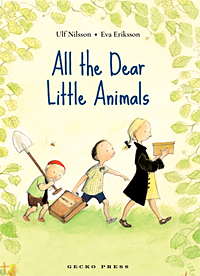All the Dear Little Animals
by Ulf Nilsson
illustrated by Eva Eriksson
Date: 2009
Publisher: Gecko Press
Reading level: C
Book type: picture book
Pages: 36
Format: e-book
Source: NetGalley
This is a picture book for children aged five and up, and covers a difficult subject in an unsentimental way. It describes exactly the way children resolve big issues--through play.
(synopsis from Goodreads)
Apparently, European authors like writing children's books about death. When I think back over the ones I've read recently, most seem to have been written by Europeans. Many of those books are translated, which may be part of the reason I've yet to really love any of them; something is usually lost in translation.
That seems to be the case here in All the Dear Little Animals, which (intentionally or not) comes across as overly Christian, potentially traumatizing, and a bit narcissistic. One day, feeling bored, Esther and her friend (the narrator) start a funeral business for the neighbourhood's dead creatures. Esther buries them, while her friend writes poems to honour them. But Esther soon gets tired of burying insects, and annoyed that people won't recognize her virtue (or pay her for her services). All is well, however, when they find a dead hare and then a stunned blackbird. By the end of the day, the kids are feeling overly proud of themselves... but the book ends by implying that all this funeral business was just a whim, and the kids are going to move on to doing something else.
I get that maybe the book's trying to show kids as they really are, but children don't come off very well here. Some of the statements made reminded me a little too much of Trump:
We were very kind and good, looking after the dead animals. We were the nicest people in the world.
A few more things bothered me about this one. First is the fact that Esther felt the need to bury everything, ignoring the fact that nature takes care of these things in its own way. Insects, birds, and rodents won't break down as well if they're encased in cigar boxes (or suitcases!). Second, I don't like the way the Christian view of burial is pushed. This could've been an opportunity to teach about various death practices... but instead, all the dead critters get burials with hymns. And that's after they're baptized. Third, I don't like the way sleeping and death are conflated. That's a recipe for trauma and sleepless nights right there. And fourth... oh, poor Little One. When a bird flies into a window and stops moving, it isn't necessarily dead. Sometimes it's just stunned. But the kids buried it anyway!
The illustrations here are kind of cute, but I'm really not a fan of the narrative. It has the potential to be confusing for young children, and it features a very unlikable protagonist in Esther. When all is said and done, she just comes across as someone who does "good" deeds because she wants recognition... not because it's the right thing to do. (The fact that the funeral business is abandoned the very next day pretty much undermines any message about kindness or respect for the dead.)
Overall, I don't think I'd recommend this one. For some better books about death and/or grieving, you might try Cry, Heart, But Never Break by Glenn Ringtved, Maybe Dying Is Like Becoming a Butterfly by Pimm van Hest, Always Remember by Cece Meng, or My Big, Dumb, Invisible Dragon by Angie Lucas.
Thank you to NetGalley and Gecko Press for providing a digital ARC.
Premise: 2/5
Meter: n/a
Writing: 3/5
Illustrations: 3/5
Originality: 2/5
Enjoyment: 2/5
Overall: 2.33 out of 5



No comments:
Post a Comment